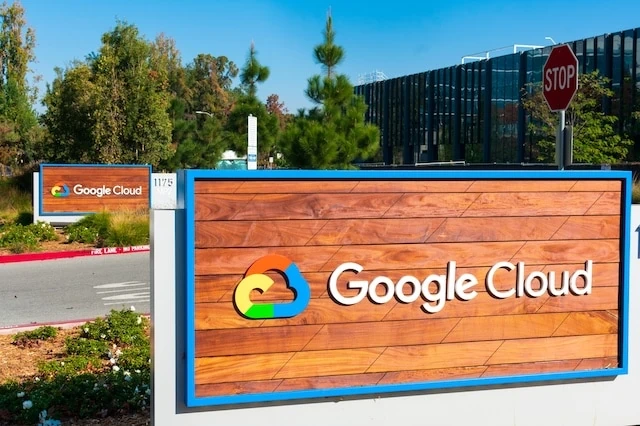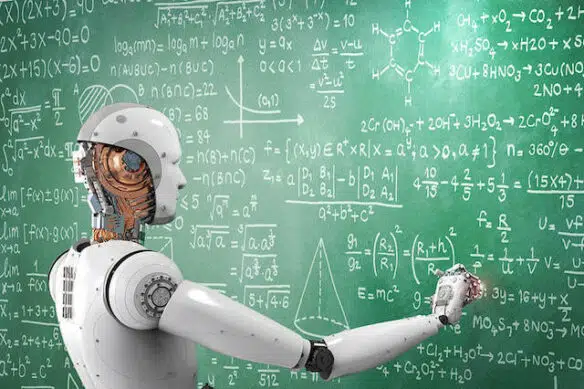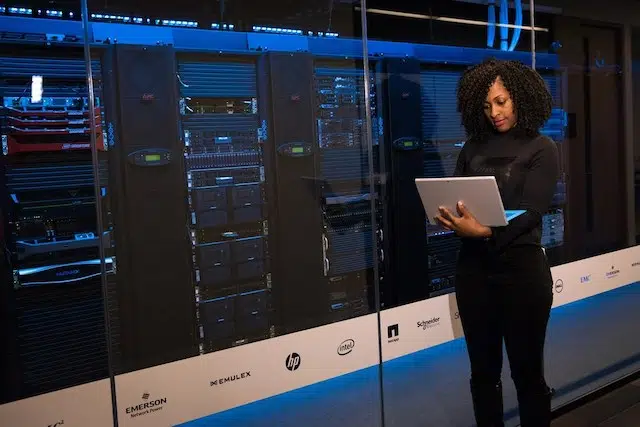Artificial intelligence (AI) has always been a source of fascination for us, especially when it comes to how things can go wrong. From sci-fi thrillers like The Terminator and I, Robot to regular old science fiction exploration films like A.I. Artificial Intelligence and Bicentennial Man, popular media makes AI and the ethics and dangers surrounding it a common topic of study.
Fast-forward to the present day, and what was once thought of as unrealistic movie scenarios are now playing out in the real world. Spam detection in your inbox, Tesla’s self-driving cars, Amazon Alexa, and even your Netflix movie recommendations are all real-world applications of AI—and more specifically, machine learning.
What is machine learning and just how prevalent is it in our lives? Read on to find out.
Table of Contents
Featured Financial Products
What Is Machine Learning?
Machine learning (ML) is a type of artificial intelligence that involves the development and use of computer systems that can learn about and make predictions based on datasets without the need to follow explicit human instructions.
Generally, machine learning models use algorithms and statistical models to process historical data as an input, then use trends in this data to predict new output values. ML techniques are designed to make these predicted outcomes more accurate without the help of programming specifically tailored to produce a solution.
Said plainly: Machine learning platforms and software applications analyze data and draw conclusions from patterns it detects in that data.
Many common applications of machine learning technology are found in business, where it is used to improve performance in:
- business analytics
- risk management
- performance analysis
- reducing operating costs
- assessing market opportunities
While business analytics and data-driven sports decisions may grab the bulk of the attention, applications for machine learning abound, and the market is rapidly expanding. For instance, some are seeking to adopt machine learning for meaningful tasks such as detecting breast cancer, or for financial gain by predicting stock market highs and lows.
No matter the use case, machine learning adoption has grown by leaps and bounds in the past decade. In fact, you probably interact with machine learning applications on a daily basis without even realizing it. Machine learning is used in:
- email filters to sort out spam
- internet search engines to understand user intent and result relevancy
- banking apps to detect unusual or fraudulent activity in your bank accounts or credit cards
- word processing software using natural language processing (NLP) to predict what words you’ll write next
Given a vast global machine learning market, it’s nearly impossible to not interact with some application of artificial intelligence in our daily lives.
But to get an idea of just how large this technological revolution this is, check out these top machine learning statistics and trends.
Related:
- Best Kid Debit Cards
- Best Debit Cards for Teens
- Best Free Debit Cards for Kids and Teens
- Best Prepaid Debit Cards for Kids and Teens
Machine Learning Statistics: Market Size + Market Trends

1. Machine Learning Market Size
The global machine learning market size is an estimated $21.17 billion in 2022 and is expected to reach $209.91 billion by 2029. (Source: Fortune Business Insights)1
2. Market Share
The IT and Telecommunication industries comprise 21.5% of the market share by end user in 2022. (Source: Fortune Business Insights)1
3. Growth Rate
The compound annual growth rate of the machine learning market is forecast to be 38.8% between 2022 and 2029. (Source: Fortune Business Insights)1
4. Driving Forces for Machine Learning Growth
The increased adoption and advancement of technology and automation—including cloud-based platforms, networking systems, integrated memory systems, and AI-inbuilt processors—allow complex problems to be solved quickly and is the main driver of projected machine learning market growth. (Source: Market Research Future)2
In particular, increasing utilization in the healthcare sector is driving the growth of machine learning applications. Within healthcare, one of the most important applications is the “detecting and diagnosing illnesses and conditions that are sometimes difficult to identify.” (Source: Fortune Business Insights)1
5. Key Players Driving Machine Learning
The key companies in the machine learning sphere include Amazon, Microsoft, Oracle, Intel, IBM, Hewlett Packard Enterprise, SAP, SAS Institute, FICO, and BigML. (Source: Fortune Business Insights)1
Related: Best Brokerage Account Sign-Up Bonuses, Promotions and Deals
Featured Financial Products
Machine Learning Statistics: Employment Prospects

6. Jobs Using Machine Learning
There were 33,500 computer and information research scientist jobs in 2021. That number is expected to grow to 40,600 by 2031. (Source: Bureau of Labor Statistics)3
7. Employment Prospects From 2022 Through 2032
Computer and information research scientist jobs are expected to grow by 21% between now and 2031, while computer operations jobs are expected to grow by 15%. That’s extremely rapid compared to the 5% expected total growth for all other occupations during the same timeframe.
Furthermore, 3,300 openings on average are projected each year for computer and information research scientists due to the need to replace workers who change fields or exit the labor force. (Source: Bureau of Labor Statistics)3
8. Average Compensation of Jobs Using Machine Learning Skills
The median annual compensation for computer and information research scientists was $131,490 in 2021, with the lowest 10% earning less than $74,210 and the highest 10% earning more than $208,000. (Source: Bureau of Labor Statistics)3
9. Leading Business Use Cases of Machine Learning
Reducing costs is the leading business use case of machine learning at 38%, followed closely by generating customer insights/intelligence (37%), improving customer experience (34%), and internal processing automation (30%). (Source: Algorithmia)4
10. Number of Data Scientists at Companies Often at 10 or Less, But Still Growing Rapidly
The number of data scientist roles at companies ballooned between 2018 and 2020. Currently 89% of companies had at least one data scientist in 2020, up from 76% in 2018.
In 2018, 9% of companies reported employing 11-50 data scientists, and that number jumped to 20% by 2020.
Meanwhile, the number of companies with 51 and 100 data scientists grew from a 2% share to 5%; the number with 101 to 1,000 grew from a 5% share to 11%; and 3% of companies reported more than 1,000 data scientists in 2020, “indicating small but significant growth” from 2% in 2018. (Sources: Algorithmia)4
If U.S. projections are any indication, expect the number of data scientist jobs in the world to keep growing. America has 113,300 data scientist jobs in 2021; that’s projected to grow by 40,500 roles by 2031. (Source: Bureau of Labor Statistics)5
11. Machine Learning Operationalization Is Fledgling But Maturing
In 2020, just more than 22% of companies have had machine learning models in production for one to two years. While that sounds small, that’s a huge leap over the prior year’s 13%, “demonstrating a fairly significant migration toward productionization even if it is still early days for most companies.”
On top of that, another 20% said they planned on having models in production by 2021. (Source: Algorithmia)4
12. Main Challenges People Face When Developing ML Capabilities
“The main challenges people face when developing ML capabilities are scale, version control, model reproducibility, and aligning stakeholders.” (Source: Algorithmia)4
13. Average Time It Takes to Deploy a Machine Learning Model and Machine Learning Algorithm
The most common timeframe to deploy a machine learning model is eight to 30 days (28%), followed by 22% taking 31-90 days, 13% taking 91-365 days, 14% taking 0-7 days, and 5% taking 1+ years. The remaining 18% are unsure of their typical timeline. (Source: Algorithmia)4
14. Budgets for Machine Learning Programs Are Growing Most Often By 25%
While ML budgets vary according to industry and stage of maturity, overall, budgets for machine learning are growing regardless of company size.
From 2018 to 2019, 43% of companies surveyed increased their budget by 1%-25%, 21% increased their budget by 26%-50%, 4% increased by 51%-75%, and 3% increased by more than 75%.
Of the remainder, only 2% decreased their ML budgets, while 27% kept them level. (Source: Algorithmia)4
15. Fastest-Growing Industries for Developing and Deploying Machine Learning Models Are Banking, Manufacturing, And IT
In the banking and financial services sector, 40% of companies surveyed increased their ML budgets by 40% while a further 27% increased by 26%-50%.
In manufacturing, 43% of companies surveyed increased their ML budgets by 1%-25% while a further 29% increased by 26%-50%.
Finally, 47% of information technology companies increased their ML budgets by 1%-25% while a further 20% increased by 26%-50%. (Source: Algorithmia)4
16. Microsoft Power BI Emerging as One of the New Top Skills for Data Analysis Roles
While Microsoft Power BI has become one of the top skills needed for data analysis jobs, those who already have data analysis skills might be able to quickly adapt. That’s because there’s an 83% similarity between data analysis and Microsoft Power BI. (Source: LinkedIn)6
Do you want to get serious about saving and planning for retirement? Sign up for Retire With Riley, Young and the Invested’s free retirement planning newsletter.
Related:
Machine Learning Statistics: Applications

17. Applications in Healthcare
Medical use cases of machine learning algorithms and deep learning are on the rise. The major growth areas for ML applications in the healthcare field are identifying diseases, diagnosis, and medical imaging (Source: Fortune Business Insights)1
18. Applications in Media
Machine learning and deep learning are responsible for 80% of the movies, shows, and documentaries watched on Netflix. (Source: ResearchGate)7
19. Applications in Social Media
Facebook uses an artificial intelligence-powered face recognition model to achieve greater than 97% accuracy in face verification. (Source: Facebook)8
20. Applications in Clean Energy
Through the application of AI and ML, machine learning companies Google and DeepMind provide turbine output prediction software that, as of 2019, improved the “value” of wind energy production versus a production baseline of turbines without such software.
The software has continued to show strong results, to the point where French utility Engie SA agreed in 2022 to use the technology in its European wind farms. (Source: The Verge, Bloomberg)9,10
Related:
Featured Financial Products
Machine Learning Statistics: Deep Learning

Deep learning is a subset of machine learning and utilizes algorithms that analyze data with a logical structure similar to that of the human brain.
“The design of such an ANN is inspired by the biological neural network of the human brain, leading to a process of learning that’s far more capable than that of standard machine learning models.” (Source: Levity)11
One growing application of deep learning techniques is voice assistant technology such as Siri, Google Assistant, and Alexa.
21. Deep Learning U.S. Market Size
The U.S. deep learning software market size is estimated to explode from $80 million in 2017 to $930 million by 2025. (Source: Statista)12
22. Deep Learning Global Market Size
The global deep learning software market size is expected to enjoy a compound annual growth rate of 39.2% between 2020 and 2027, reaching $44.3 billion by the end of the forecast period.(Source: ReportLinker)13
23. Use of Deep Learning Voice Assistant Technology
In 2019, approximately 3.5 billion people were using voice-activated search and assistants globally, which equates to a little less than half the world population. It’s predicted that the number will increase to 8 billion by 2023. (Source: Juniper Research)14
24. Global Natural Language Processing Market
Between 2021 and 2026, it’s estimated that the value of the global natural language processing market will grow at a compound annual rate of 26.84% and reach $48.46 billion. (Source: Mordor Intelligence)15
Do you want to get serious about saving and planning for retirement? Sign up for Retire With Riley, Young and the Invested’s free retirement planning newsletter.
Related:
- Best Stock Trading Apps for Beginners
- Best Investment Apps for Beginners
- Best Investment Apps and Platforms
- Best Online Brokers [Low-Cost Discount Brokerage Accounts]
- Best Robo-Advisors to Invest in a Diversified Portfolio Automatically
Machine Learning Statistics: Milestones

Machine learning has drastically advanced AI capabilities in recent years. What is artificial intelligence capable of so far?
25. Healthcare
In 2019, Google’s lung cancer detection application was able to outperform human radiologists with an average of eight years’ experience. (Source: VB)16
26. COVID-19
Machine learning was able to predict the mortality of COVID-19 patients with 92% accuracy in 2020. (Source: Nature)17
27. Stock Market
In 2017, machine learning was able to provide a useful stock-trading signal by reading biotechnology companies’ annual reports. “In this model, we are seeing 62% accuracy for predicting the under-performing company based on the sample 10-K text.” (Source: Microsoft)18
Related: 15 Best Investing Research & Stock Analysis Websites
28. Speech Recognition
The error rate of speech recognition systems was less than 5% as of 2019. (Source: Teks Mobile)19
29. AI Writing
In its first year in 2016, the Washington Post AI writing program (called Heliograf) produced 850 stories about topics ranging from high school football games to political races. (Source: WNIP)20
30. Autonomous Vehicles
As of July 2022, Tesla vehicles had driven 35 million autonomous miles under the Full Self-Driving (FSD) Beta. (Source: Tesla)21
Featured Financial Products
Related Machine Learning Statistics Questions

How are statistics used in machine learning?
Statistics is the study of and manipulation of data. It contains a collection of tools and methods for evaluating, displaying, and interpreting sets of data, which can then be used to make decisions.
Machine learning algorithms use statistics to identify data patterns and convert those patterns into useful information, which data scientists and others then use to make informed decisions.
How fast is machine learning growing?
Machine learning worldwide was valued at $15.44 billion in 2021 and is an estimated $21.17 billion in 2022. By 2029, the global market is expected to grow to $209.91 billion, or a compound annual growth rate of 38.8% during the forecast period. (Source: Fortune Business Insights)1
Related: Alarming Data Privacy Statistics, Trends and Facts
What are the differences among machine learning, AI, and data mining?
Artificial intelligence (AI) involves creating machines that can think and make decisions similar to humans. “Data mining is considered the process of extracting useful information from a vast amount of data. … On the other hand, machine learning is the process of discovering algorithms that have improved courtesy of experience derived from data” Put more simply, data mining is more akin to research, while machine learning is more akin to teaching machines how to use data and become more intelligent. (Source: Simplilearn)22
Will machine learning replace jobs?
Yes and no. While it is true that machine learning and related AI systems are quickly replacing repetitive jobs that can be more easily automated, the growth in the machine learning market has led to increased job opportunities in the fields of computer science and data engineering. With the rapid growth of machine learning adoption, it’s certain that these in-demand skills will also lead to the creation of millions of new jobs (including, of course, machine learning engineers). (Source: Built In)23
What are the drawbacks to machine learning?
Machine learning is only as good as the data it has available to it. If data collection is inadequate, then the machine learning algorithm will fail to produce meaningful predictions and information.
Thus, a machine learning algorithm needs large sets of good data to train on, plus the time to learn and develop, and adequate computing power to run.
Furthermore, because machine learning is dependent on the availability of large amounts of quality data, it is highly susceptible to error. Small training data sets often contain biases, which could result in biased and errored predictions. (Source: HBR)24
Machine Learning Statistics + Trends in 2021 and 2022 Sources:
- Fortune Business Insights (https://www.fortunebusinessinsights.com/machine-learning-market-102226)
- Market Research Future (https://www.marketresearchfuture.com/reports/machine-learning-market-2494)
- Bureau of Labor Statistics (https://www.bls.gov/ooh/computer-and-information-technology/computer-and-information-research-scientists.htm)
- Algorithmia (https://info.algorithmia.com/hubfs/2019/Whitepapers/The-State-of-Enterprise-ML-2020/Algorithmia_2020_State_of_Enterprise_ML.pdf?hsLang=en-us)
- Bureau of Labor Statistics (https://www.bls.gov/ooh/math/data-scientists.htm)
- Linkedin (https://linkedin.github.io/future-of-skills/)
- ResearchGate (https://www.researchgate.net/publication/318671349_Deep_Learning_Based_Recommender_System_A_Survey_and_New_Perspectives)
- Facebook (https://research.facebook.com/publications/deepface-closing-the-gap-to-human-level-performance-in-face-verification/)
- The Verge (https://www.theverge.com/2019/2/26/18241632/google-deepmind-wind-farm-ai-machine-learning-green-energy-efficiency)
- Bloomberg (https://www.bloomberg.com/news/articles/2022-06-01/google-and-france-s-engie-team-up-to-accelerate-wind-power)
- Levity (https://levity.ai/blog/difference-machine-learning-deep-learning)
- Statista )
- ReportLinker )
- Juniper Research (https://www.juniperresearch.com/press/digital-voice-assistants-in-use-to-8-million-2023)
- Mordor Intelligence (https://www.mordorintelligence.com/industry-reports/natural-language-processing-market)
- VB (https://venturebeat.com/ai/googles-lung-cancer-detection-ai-outperforms-6-human-radiologists/)
- Nature (https://www.google.com/url?sa=t&rct=j&q=&esrc=s&source=web&cd=&ved=2ahUKEwjW0saRy8L6AhXBOn0KHdE1DV8QFnoECAcQAQ&url=https%3A%2F%2Fwww.nature.com%2Farticles%2Fs41598-020-75767-2.pdf%3Forigin%3Dppub&usg=AOvVaw0ZtNrOp9ta1UJvGq04P1gJ)
- Microsoft (https://devblogs.microsoft.com/cse/2017/12/04/predicting-stock-performance-deep-learning/)
- Teks Mobile )
- WNIP (https://whatsnewinpublishing.com/the-washington-posts-robot-reporter-has-published-850-articles-in-the-past-year/)
- Tesla (https://tesla-cdn.thron.com/static/EIUQEC_2022_Q2_Quarterly_Update_Deck_J8VLIK.pdf)
- Simplilearn (https://www.simplilearn.com/data-mining-vs-machine-learning-article)
- Built In (https://builtin.com/artificial-intelligence/ai-replacing-jobs-creating-jobs)
- HBR (https://hbr.org/2018/04/if-your-data-is-bad-your-machine-learning-tools-are-useless)
Related:






![17 Best Income-Generating Assets [Invest in Cash Flow] 17 income generating assets cash flow](https://youngandtheinvested.com/wp-content/uploads/income-generating-assets.jpg)

